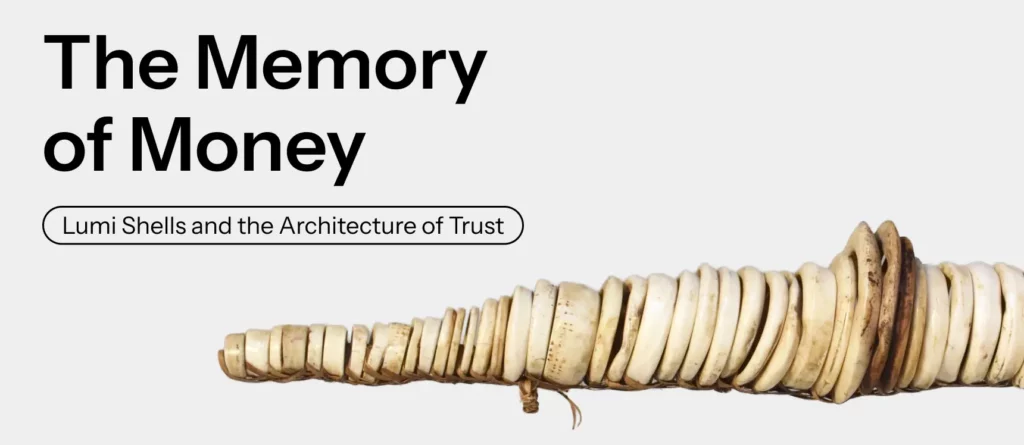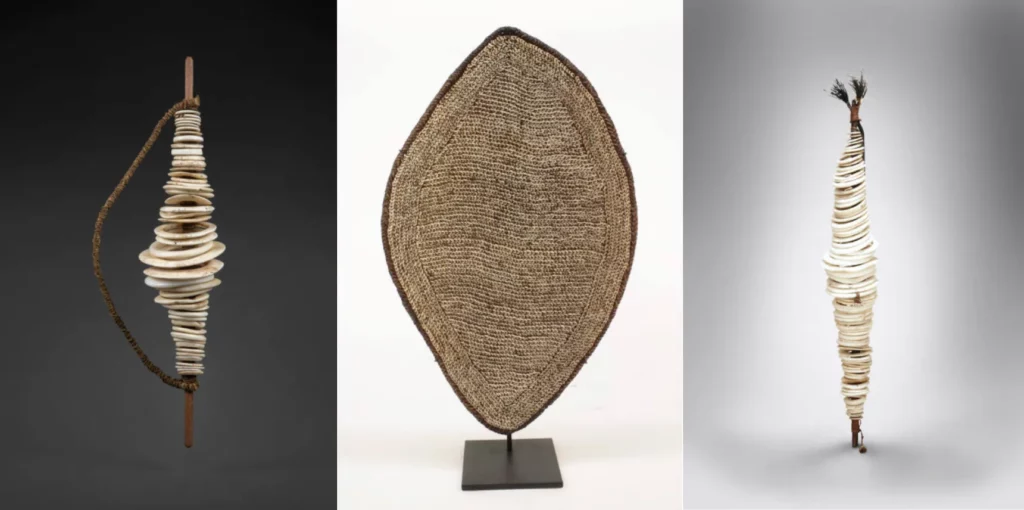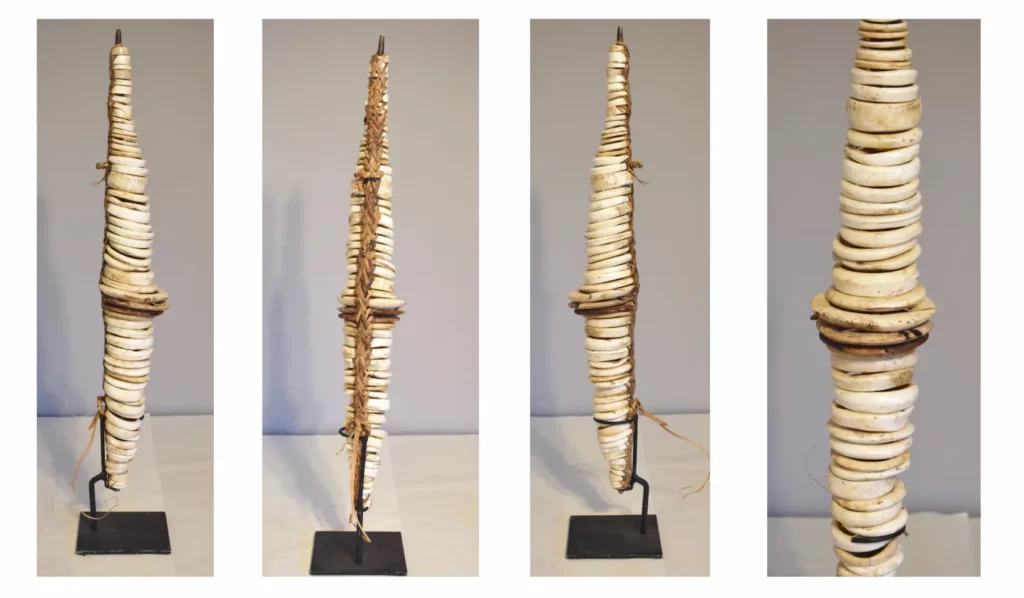
- The Money Sticks: Physical Ledgers of Trust
- The Shell Mats and Marriage Traditions
- Trust and Community in Lumi Culture
- The Collapse of Trust: Why It Couldn’t Scale
- Conclusion: The Rediscovery of Trust
In the humid rainforests of Papua New Guinea, shells and wooden sticks formed the backbone of an economy. These were not mere objects. They were repositories of memory. Promises were etched into wood, debts sewn into shell-covered mats, and every transaction was validated by the watchful eyes of the community. It was a system of trust, where memory replaced ledgers and public witness replaced contracts. Shells and sticks were chosen for their durability and symbolic value, enabling them to represent promises across generations.
For the Lumi, money was more than a means of exchange; it was a way to bind communities, record history, and preserve trust. Each shell and stick carried not just economic value, but social meaning, woven deeply into the fabric of everyday life.

source: Collections – eMuseum
The Money Sticks: Physical Ledgers of Trust
Money sticks were more than carved wood. They were physical embodiments of trust within the Lumi community, enduring for several centuries as a stable and resilient form of memory-based money. While exact dates are challenging to pinpoint, historians estimate that this system existed well before the 20th century. Evidence for this is seen in how these money sticks were often passed down through generations, with additional shells added over time, signifying the accumulation of wealth and social status.
Each stick was adorned with shells, meticulously arranged to represent specific obligations, whether debts, promises, or transactions. These sticks were crafted and presented in communal settings, with elders and community members bearing witness. The collective recognition of the shell arrangements ensured that each obligation was acknowledged and honored, making deception nearly impossible.
Custodians of these sticks bore the responsibility of safeguarding these agreements, serving as living banks that upheld the community’s economic and social fabric. Attempts to alter the arrangement or deny the agreement would be known by the entire community, reinforcing trust through collective memory. Money sticks did not just document transactions; they enforced them through the power of shared memory.

source: WorldofBacara – Papua New Guinea Lumi Money Shell Stick Brides Price
The Shell Mats and Marriage Traditions
For larger transactions, the Lumi used Poli mats, which were handwoven textiles covered in tiny Nassa shells. These mats represented wealth and were often used in marriage ceremonies. When a groom’s family presented a Poli mat to the bride’s family, it wasn’t just a financial exchange. It was a public promise, a commitment witnessed by the entire community. This act bound families together, solidifying the transaction in public memory.
The shells were sewn with precision, representing family wealth and commitment. When the groom’s family presented the mat, it was not just an exchange. It was a public vow that bound the families with memory. It symbolized trust and unity, witnessed by everyone present. Much like the money sticks, this public display ensured accountability, as everyone remembered the event and the obligations tied to it.

source: https://www.oceanicartsaustralia.com/art-for-sale/old-woven-shell-currency-matt-lumi-area-2/
Trust and Community in Lumi Culture
The key to this system was public memory. Transactions were not private or hidden. They were community events. If you borrowed shells or created a money stick, the entire community knew. Failing to honor a commitment led to immediate and severe social consequences. Trust was not mediated by courts or enforced by written contracts. It was upheld by the memory of the people who witnessed it.
This trust was decentralized. There were no vaults or courtrooms, only the memory of the village. Every person was part of the ledger, with each transaction etched into the minds of the community. It was a distributed ledger, secured by communal awareness. The strength of the system lay in its transparency. Everyone knew who owed what, and attempts to deceive would result in social ostracism.
The Collapse of Trust: Why It Couldn’t Scale
The arrival of colonial powers dismantled this system intentionally, replacing community-led trust with centralized control. Papua New Guinea was rich in natural resources like gold, timber, and later, oil. To efficiently exploit these resources, colonial authorities imposed their own currency to standardize transactions and enforce economic control. European authorities imposed fiat currency and centralized banking, erasing the local economy’s ability to self-regulate. This was not simply economic ‘modernization.’ It was a strategic takeover designed to centralize power and strip local communities of their sovereignty over value. Suddenly, value was represented not by shells and sticks but by paper money controlled by distant banks. The community’s role in verifying and enforcing transactions was replaced by institutions with no local accountability.
Conclusion: The Rediscovery of Trust
Lumi’s trust-based system was erased by colonial powers, but its principles of trust, transparency, and community validation are timeless. While colonial forces dismantled Lumi’s communal memory, Bitcoin has resurrected it. Not in shells, but in immutable code. Lumi shells and money sticks relied on community memory; Bitcoin uses blockchain technology to secure trust without a central authority. Transactions are recorded on a public ledger, verified not by witnesses in a village, but by thousands of nodes across the globe. It is public, transparent, and immutable.
Bitcoin revives the idea that money is memory, an idea as old as civilization and now rediscovered in digital form. It replaces shells and sticks with cryptographic proof, ensuring that transactions are transparent, permanent, and immune to manipulation. Colonial powers stripped the memory of value from the community, placing it in distant banks. Bitcoin returns it to the hands of individuals, secured by code and verified by a global network.
What Lumi culture achieved through communal memory, Bitcoin now accomplishes with cryptographic proof. It represents the next step in the evolution of money: resilient, transparent, and free from centralized control.
